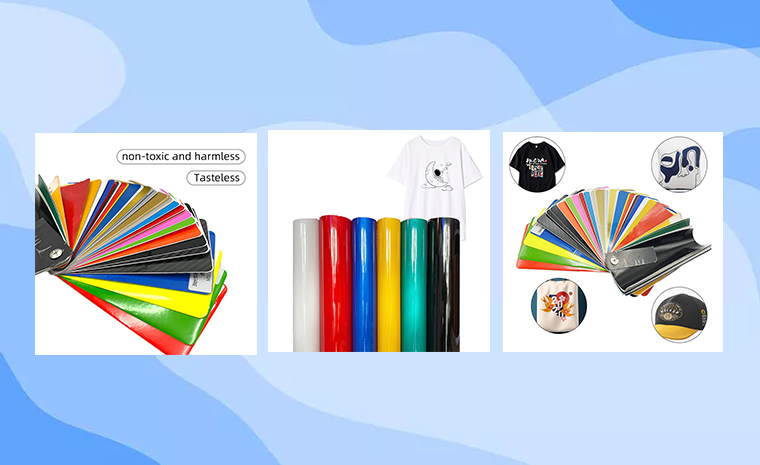Was ist Vinyl-Wärmetransferdruck?
What is Vinyl Heat Transfer Printing?
The Basics
Heat transfer vinyl printing is one of the most cost-effective and simple ways to create custom-printed products. Most business owners intending to make printed t-shirts or other apparel will most likely start with this process. This method requires only a small investment to get started and requires less technical savvy than other printing methods.
While there are different variations of printing that call for a heat press to transfer images to products, like dye-sublimation printing, this article covers the heat transfer process using a single color vinyl material. Heat transfer vinyl printing, or HTV, uses vinyl polymer that comes on a roll or in flat sheets. It is usually a single color with an heat resistant backing. It can be heated with a heat press or iron. Heat transfer vinyl is cut, weeded and then heat pressed onto fabric.
In this article we will cover the basics of Heat Transfer Vinyl Printing including the printing process, general equipment needed, along with some helpful pros and cons of this printing method.

The Production Process
Although heat press vinyl can be cut by hand and applied by using an ordinary iron, this section will focus on heat transfer production printing found in many commercial print shops. The process starts with creating or converting artwork into vector format using vector software. Since heat press vinyl artwork is pressed onto fabric, it must be flipped on the horizontal axis, making it backwards when cut. The plotter or cutter cuts out the design on the vinyl. An electronic plotter will use a small knife guided by a computer using X and Y axis coordinates to cut complicated designs.
The next step is to remove the parts of the vinyl that are not part of the final design. This process is called “weeding.” With cut vinyl it is often tricky to discern which pieces must remain and which are to be weeded or taken out. Therefore it is critical to reference an image of the design you are weeding, which will help you to remove only the sections that will not be part of the final print. Once the vinyl is cut and weeded it can be positioned on the fabric.
Using the right temperature, pressure and duration of press is critical to the longevity of the print. So make sure that your heat press settings are following the specs given by the vinyl manufacturer. It is also important to note that different types of fabrics will require different temperature, pressure and time. Once you press the vinyl onto the fabric, you can remove the backing material. Depending on the vinyl specs this is either while the material is still hot or only after it has cooled. This is referred to as a “hot” vs. “cold” peel.
Equipment Needed
The equipment that is needed for the basics of heat transfer vinyl printing are relatively inexpensive when compared to other commonly used printing methods. Only 4 major items are needed to print successfully with this method.
They are listed below:
Vector Software
When purchasing a plotter or cutter, the vendor usually supplies corresponding software capable of creating simple designs or at least turning regular raster images into cut-able designs. Initially it’s not necessary to purchase state-of-the-art vector software, like Adobe Illustrator or Corel Draw, to begin making heat press designs. However if you want to expand in this industry it might be a good investment down the road, especially if you wish to create more complex designs. Most modern print shops use Illustrator or Corel Draw to import, re-size or create a design, then export the design to the plotter software, which reorients the file and sends it to the cutter.
Vinyl Plotter or Cutter
The plotter produces intricately cut designs on all different kinds of vinyl, not only on heat transfer vinyl but also on pressure sensitive vinyl used for sticker and decal production. Plotters come in various sizes with a range of functionality. Some are small desktop versions designed for the hobbyist, while other larger format stand-alone models are intended for medium and large scale production.
Consider the goal and scale of operation when choosing a plotter. The main focus should be on the size of prints you would like to produce. The crucial difference between cutters come down to print width, so decide on the maximum size you need your plotter to handle and make sure to do your research.
There are a huge variety of heat presses on the market, from manual to partly and fully automatic. The two items to be concerned about in a heat press are its temperature and pressure settings. Most machines will have these settings with built in adjustments. It is wise to check, before purchasing, that your machine is capable of performing the pressure and temperature settings that your vinyl specs demand.
If routine, large-scale production will be part of your operation, a timer with a release mechanism will prove essential. The timer automatically releases your press at a specified time, which prevents a garment from being over heated and possibly ruined. Conversely an automatic timer release will also prevent the press from being under heated which results in low print quality and an image that will peel off after a short period of time.
